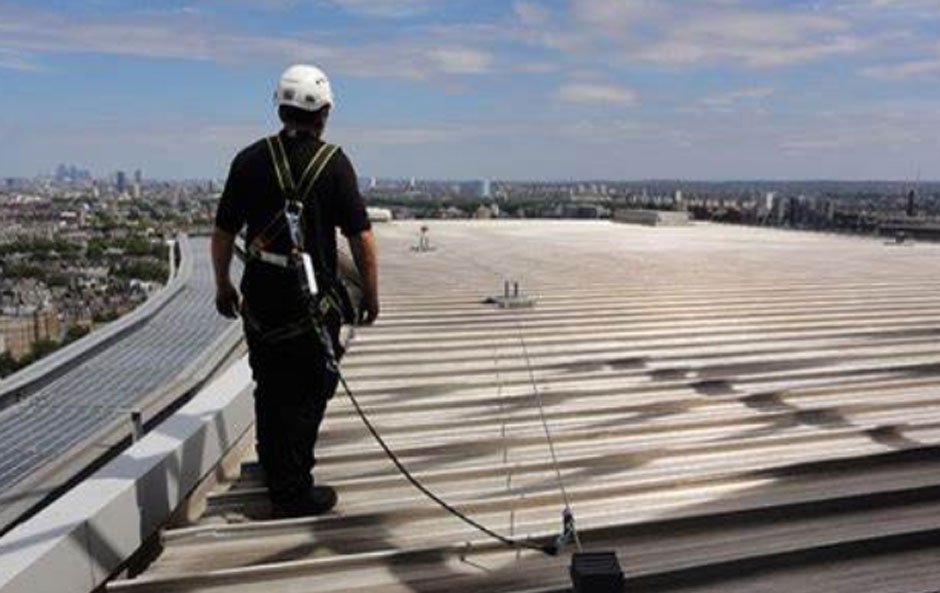Skip to the good bit
ToggleWorkplace safety is a top concern in construction, warehousing, maintenance, and other sectors where working at height poses significant risks. Horizontal lifeline (HLL) systems represent one of the most effective solutions for mitigating these hazards. By providing continuous fall protection, these systems enable workers to navigate elevated areas with increased safety.
This article examines the functionality of horizontal lifeline systems, their adaptability across various industries, integration with self-retracting lanyards (SRLs), and how they enhance workplace safety standards.
Understanding Horizontal Lifeline Systems
A horizontal lifeline is a fall protection system designed to allow workers to move freely along an elevated area while still secured to a lifeline that runs horizontally across the work zone. These systems are typically installed on rooftops, bridges, or other elevated platforms where employees are required to work at height.
Unlike traditional fall arrest systems, which are fixed to a specific point, horizontal lifelines are flexible and allow workers to move along the line, providing a wider range of motion. The system comprises several key components: the lifeline (a strong rope or steel cable), anchor points, and shock absorbers. When properly installed and used, horizontal lifelines offer superior fall protection, reducing the risk of injury or death from falls.
How Horizontal Lifelines Work
The essential function of a horizontal lifeline system is to prevent a worker from falling from an elevated work surface. The lifeline is typically anchored at both ends to strong, stable structures such as building walls, steel beams, or other secure fixtures. The lifeline is usually a high-strength steel cable or a synthetic line designed to withstand the force exerted during a fall.
When a worker connects to the horizontal lifeline via a full-body safety harness and a lanyard, they are protected against falls while moving along the lifeline with relative ease. In the event of a fall, the fall-arresting components of the system engage, preventing the worker from impacting the ground or falling too far.
One key advantage of horizontal lifelines is the ability to move continuously along the system. In contrast to traditional fall protection systems, such as fixed anchor points or vertical lifelines, horizontal lifelines provide flexibility and safety in areas where workers need to move between two points while performing tasks. This adaptability makes them ideal for use in dynamic environments such as construction sites, manufacturing facilities, and warehouses.
Advantages of Horizontal Lifelines
Continuous Protection
Horizontal lifeline systems offer continuous fall protection, keeping workers safely connected as they move across large work zones. Unlike fixed anchor points, these systems provide flexibility and freedom while ensuring safety and eliminating exposure to fall hazards.
Adaptability Across Industries
Horizontal lifelines are adaptable across a wide range of industries. They can be installed on rooftops, bridges, towers, and industrial facilities, making them a vital tool in fields such as:
- Construction: Workers on construction sites are often required to work on scaffolding, roofs, and other elevated platforms. Horizontal lifelines provide continuous protection as workers move between areas and perform tasks such as roofing, installation, and maintenance.
- Warehousing and Distribution: Workers may need to navigate high shelving units or storage areas in warehouses and distribution centers. Horizontal lifelines allow employees to move around safely, preventing falls when working at height.
- Maintenance and Inspection: Technicians performing maintenance on elevated equipment, such as wind turbines, utility towers, or bridges, rely on horizontal lifeline systems to stay secure while accessing difficult-to-reach areas.
Enhanced Safety in High-Risk Work Zones
In many work environments, falls are a leading cause of injuries or fatalities. Horizontal lifelines significantly reduce this risk by ensuring workers are always secured while working at height. The continuous fall protection these systems provide is particularly important in high-risk industries where employees are exposed to dangerous working conditions.
By reducing the likelihood of falls, horizontal lifelines also lower the chances of costly workers’ compensation claims, equipment downtime, and negative impact on a company’s reputation due to safety incidents.
Customizable Systems for Specific Needs
Horizontal lifelines are highly customizable to meet each work environment’s unique requirements. The system can be designed to fit the specific dimensions and layout of the work area, accounting for factors such as the building structure, type of work performed, and number of workers who need protection.
These systems can be permanent or temporary, depending on the nature of the work. For example, in construction or maintenance scenarios where the work zone is temporary, a temporary horizontal lifeline can be set up and removed once the task is completed. Permanent systems, on the other hand, are suitable for facilities where regular access to elevated areas is required.
The Role of Self-Retracting Lifelines in Horizontal Lifeline Systems
Self-retracting lifelines are a necessary component to enhance horizontal lifelines’s performance and effectiveness. These devices are designed to automatically retract and extend as the worker moves along the lifeline, ensuring the worker remains securely attached at all times.
SRLs have a braking mechanism that activates when a fall occurs, quickly stopping the worker’s descent. This feature prevents the worker from falling too far or impacting the ground. SRLs provide a higher level of fall arrest protection than traditional lanyards, as they offer a shorter stopping distance and reduce forces exerted on the worker’s body during a fall.
Combining horizontal lifelines and SRLs provide a highly efficient fall protection system that enhances worker safety. The SRLs more effectively absorb the forces of a fall, while the horizontal lifeline ensures workers can move safely across elevated areas. This integration is particularly beneficial for environments where workers must move quickly and frequently, such as in construction, maintenance, or warehousing operations.
Final Thoughts
Horizontal lifelines provide a versatile, reliable solution for fall protection, especially in environments where workers must move along elevated work surfaces. These systems offer continuous protection, flexibility, and adaptability across various industries, from construction and maintenance to warehousing and distribution. By integrating SRLs, horizontal lifeline systems enhance safety by providing consistent fall arrest protection as workers move.
Implementing a horizontal lifeline system can significantly reduce the risks associated with working at height and improve overall workplace safety. Proper design, installation, maintenance, and training are vital to guarantee these systems deliver optimal performance.







